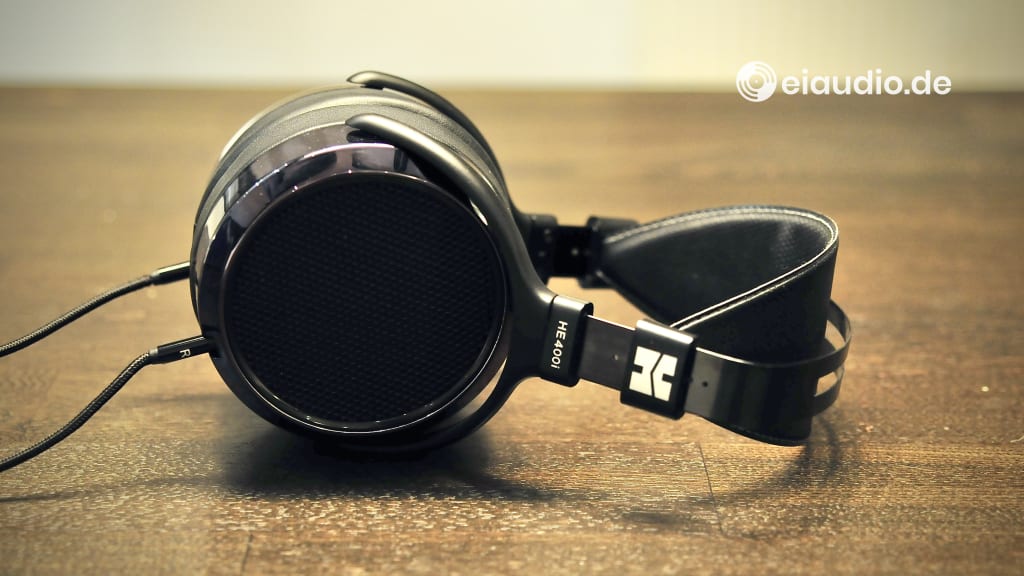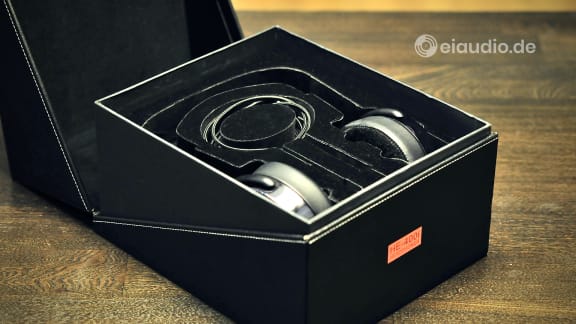HiFiMAN HE-400i
Published: 14/01/2022
Manufacturing date: 2013
Author: Karsten Hein
Category: Gear & Review
Tag(s): Headphones
The popular Chinese brand 'HiFiMAN' was founded by Fang Bian in New York. It evolved from an earlier company called 'Head-Direct' that had served as web-shop and Head-Fi sponsor. Among HiFiMAN's first products were the HE-5 planar headphones that were already launched in the founding year of 2007. Within a relatively short time, the new HiFiMAN brand became notorious for products offering excellent sound quality and advanced technology at affordable prices. Their widely successful HM-802, HE-560, and HE-400i headphones were released in 2014. Fang Bian’s design philosophy, as found on his HE-400i planar magnetic headphones, was loosely based on the much higher priced, and by then legendary, Stax electrostatic headphones. However, the planar magnetic principle never was in real-world competition with Stax in terms of sonic virtues.
In an effort to bring down production costs, HiFiMAN set up two small factories in China and moved its headquarters to Tianjin in 2011. Early HiFiMAN headphones, such as the HE-5, featured wooden ear cups that had two virtues: They looked exquisite and helped the young company to keep tooling costs down. Although the use of wood served the company well in establishing its reputation as a producer of high-quality headphones, the material was prone to cracking as it aged and dried. Some of the early HiFiMAN customers sent in complaints of cracked wooden ear cups. Hence, the revised LE-version of the HE-5 featured ear cups made of plastic and already boasted some typical traits of the company’s signature planar magnetic headphones that were to follow.
At 93 decibels sensitivity and low 35 Ohms impedance, the HE-400i headphones required only moderate amplification. In practical usage this meant that some listening pleasure could be derived, even when the headphones were connected to a smartphone or computer. This was in marked contrast to the company’s earlier planar magnetic headphones that required lots of clean power to operate, bearing some similarity to electrostatic drivers. Since affordable headphone amps with lots of power were still rare to find in those days, HiFiMAN also started to build their own dedicated headphone amplifiers, such as models EF-5 and HE-6, to power their fleet.
I began my explorations of the HE-400i planar magnetic headphones driving them with our humble Douk Audio T-3 headphone amplifier, which we had only recently upgraded with General Electric JAN 5654W tubes and an ultra-linear power supply. The interconnects used in the listening test were made of solid-core silver with copper-mesh shielding and could be unforgiving of flaws in both the setup and choice of song material. I set out listening to José González’s album “Local Valley”, which offered a mixture of male vocals, lovely guitar picking, and some minimal and delicate sound effects, such as birds singing and the occasional synthesiser support. The album provided tonal balance as well as subtle bass lines in vocals and guitars. In doing so, “Local Valley” skilfully juxtaposed the close and imminent with the vast and distant to achieve an acoustically pleasing and highly entertaining effect.
The HiFiMAN headphones had come to us packaged in a posh-looking black box clad with leatherette. In this box, the HE-400i were pressed so firmly and the cable rolled so tightly that I could not help but wonder if the box design would serve to protect its contents or rather damage the cable and ear cushions in the long run. I also noticed that the previous owner had lost or misplaced the additional 6.35 mm adaptor, because this was not enclosed it in the box. As the 3.5mm plug was angled, finding a replacement appeared to become a challenge. I put on the headphones, leaned back to listen, and immediately noticed that the original cable was too short for my sitting position. I could see how, at a mere 1.5m in length, the stiff and cloth-covered headphone cable could turn out to be too short for a whole range of applications. Replacement cables could be found online, of course. However, purchasing new cables of similar quality would drive up the price of these otherwise affordable headphones.
I thought it best to compare the HiFiMAN HE-400i with our similarly priced AKG K712 Pro headphones. According to my research, the HE-400i had initially been sold for about 400.00 EUR in Germany and then dropped in price to 200.00 EUR, before they sold out in 2018/2019. Our AKG K712 Pro first entered the market at about 300.00 EUR in Germany and then dropped to just under 200.00 EUR, following the Christmas sale of 2021. As they were similar in price and completely different in terms of technology, they seemed to be worthy opponents to me. In order not to be biased by my existing listening habits, I made sure to listen to José González’s complete album on the HE-400i first. This would give Fang Bian's planar headphones and myself some time to adjust, as I could not be sure how long they had been sitting on the shelf, before I arrived at their owner's doorstep to free them from their fate.
One of the first things I noticed was that the HE-400i planar magnetic headphones created a compact and focused image. The music seemed to be close and intimate, however, the impression was not so much of a lover whispering tender words in my ear; instead, it appeared slightly directive. The only exception to this being the birds on José González’s album, which seemed delicate and distant due to the recorded effects. There was a certain robustness to the presentation that took me by surprise and also some getting used to. And, although the ear cups were sealed with a tight metal grid that optically veiled the planar magnetic drivers underneath, the headphones provided little shielding from ambient noise. This made them ideal for critical listening in low-noise environments at home or in the studio. The fact that their music also radiated outward to considerable extent, as it did on most semi-open designs, could make them tricky to use in the monitoring of studio recordings.
The HE-400i presented lots of drive and a tonally accurate midrange, with both male and female vocals sounding natural and full-bodied. There was, however, a limited sense of spacial separation between the singer’s voice and instruments in the room. Surprisingly for planar magnetic headphones, the HE-400i more resembled our Sennheiser HD 580 in this respect. In terms of spacial and tonal separation, the conventionally driven AKG K712 Pro were far superior. Perhaps I would have expected a little more agility from planar magnetic headphones, simply because of their low-mass foil design. While the midband was quite solid and seductive, the lack of agility also showed in the treble, which cut back earlier than on the AKG. The HE-400i started dropping off at 35,000 Hz, which was almost 5,000 Hz sooner than the AKG. And, while treble extension above 22,000 Hz is considered a ‘nice-to-have’ by those pointing out the limits of human hearing, this much difference in treble performance naturally affected the ability of the driver to fully generate the impression of space and dimension in the music. On the positive side, neither the AKG nor the HIFIMAN suffered from an unpleasant accentuation of frequencies.
The HE-400i sounded less edgy when driven with sibilant music material, partly because they were less expressive in the high frequency range. They served well to highlight issues in the mid-band, where they were quite accurate. Bass performance was smooth and natural, showing a slight hump in the lower mid-bass that could have been caused by ear cup resonances interacting with the planar driver. This did contribute to a warmer and fuller sound and was not necessarily a negative aspect for music enjoyment, as it could be perceived as rather endearing. Bass roll-off was at 20 Hz, i.e., a full 10 Hz higher than on the AKG K712 Pro. While this was not a whole lot of difference, AKG did state in their sales material that the K712 Pro was designed with a +3dB increase in bass-extension. This served well to balance out the AKG’s spacious highs without being discernible as a bass-effect itself. The HE-400i seemed more compact in this discipline as well. On the whole, I found the HE-400i to be accurate and smooth-sounding headphones that lacked some refinement in terms of tonal and spacial presentation, especially in direct comparison with our highly engaging AKG K712 Pro headphones.
I had originally embarked on my tour of exploration aiming to learn about the merits of planar magnetic designs as opposed to headphones with conventional drivers. The HE-400i showed me that decent sound performance can be achieved using both concepts. HiFiMAN was still a relatively new contender on the market whose biggest contribution to Hi-Fi was to make planar magnetic designs accessible to the average consumer. However, this did not mean that conventional driver concepts needed to fear being outclassed. AKG, Beyerdynamic, and other experienced headphone manufacturers, were perfectly capable of competing from a sonic perspective and still had the upper hand in some disciplines. For planar magnetic headphones to achieve the acoustic performance of the electrostatic designs of AKG and Stax, it would take far better drivers and amplifiers than we had available with the HE-400i headphones and our humble Douk Audio headphone amp.
Specifications
- Driver type: single-ended planar-magnetic
- Design: over-ear, semi-open
- Frequency range: 20 - 35,000 Hz
- Nominal impedance: 35 Ohms
- Sensitivity: 93 dB (1mWatt, 1.000 Hz)
- Power rating: 200 mWatts, max.
- Cables: cloth-covered, Y-shaped
- Connector: detachable (mini-jack)
- Cable length(s): 1.5m
- Plugs: 3.5mm + 6.35 mm jack
- Place of manufacture: China
- Weight: 370g (without cable)
- Year(s): 2013 - 2018





